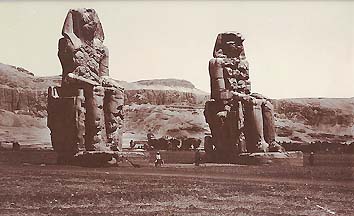The Colossi of Amenhotep

This pair of colossal statues stood before the entrance to the mortuary temple of the pharaoh Amenhotep III. The structure was the largest of any of the mortuary temples of the New Kingdom, but it was somewhat hastily built. Over time the extensive mudbrick elements of the structure melted, and later rulers quarried away what stone they found. During the Graeco-Roman period, the northern statue of the group (to the right) came to be known as the Colossus of Memnon. Memnon was a warrior who led the Ethiopian allies of the Trojans against the Greeks during the struggle for Troy. Because the prenomen of Amenhotep III, Nebmaatra, was pronounced as Nimmaria or Mimmaria, his name was conflated with the Memnon of the Trojan War. The colossal statues of Amenhotep III were damaged by an earthquake, probably in 27 B.C., and the northernmost colossus began to make a "singing" sound, probably caused by the night dew sublimating in the rising heat of morning, which was interpreted as the voice of Memnon calling to his mother, Aurora, the dawn. The Roman emperor Septimus Severus repaired the singing colossus, and it has ceased to sing down to the present day.
- Silver gelatin on glass
- 29 x 40 cm
- $480.00

